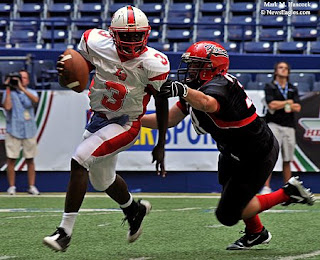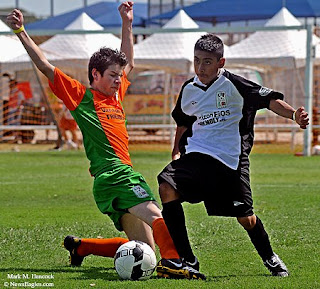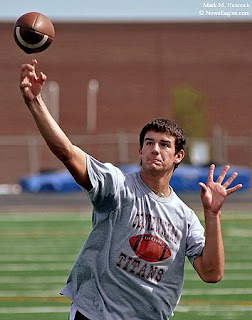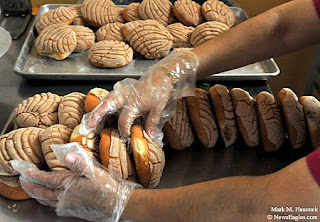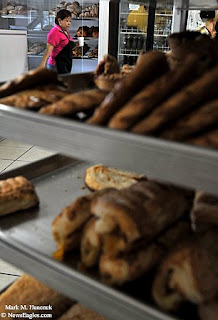Here's a program to help fix the overall economy and get us back on track. The system sounds complicated, but we already understand the principles. It merely needs to be defined into concepts we already understand.
ExplanationEach month, we all get "paid." If you're like most Americans, you actually receive computer credits through electronic funds transfer (EFT). It equates to actual cash. However, it appears in your bank rather than in your pocket as greenbacks. These electronic funds are guaranteed by the government.
We pay all our bills, go to the movies, get our coffee and perform every other function of our lives without ever touching an actual piece of cash.
At the end of the month, we've probably carried only 20 bucks in actual cash. The rest of our income and expenses were handled electronically through debit cards or checks. Everyone got their proper amount of electronic money while we earned our electronic money for the following month.
This is everyday life unless you're a strange person, who insists be being paid in gold.
SkepticismI've heard the dire warnings issued by proven liars and people who put us all into this mess in the first place. Consequently, I'm not inclined to believe them.
When I hear there is only ONE way to fix this and it involves NO oversight, I put on the brakes. This is more "
Shock Doctrine" being pushed by an exiting lame-duck president to make the greedy richer.
A fair way to spur the economyI was talking with my brother earlier this summer. The conversation turned to tax write-offs. He said he liked the option of tax write-offs, but wished they were immediate. So does everyone in business.
I've considered how this could be possible (everything is possible if there's enough will behind it). I imagine this is something any respectable politician could grab and turn to everyone's benefit.
Basic conceptThe basic concept is simple. Implementing it is slightly more difficult. However, if we look at both the short-term and long-term benefits, it's logical and fair.
The goal is to allow businesses to benefit from an immediate tax write-off upon purchase. A legitimate, tax-paying, U.S. business would essentially get to purchase business-related products and services interest-free against potential profit.
It's a legal system of barter and credit all rolled into one. The businesses benefit, the employees benefit and the government benefits.
BenefitsThe immediate benefit is an actual business and industry shopping spree and redevelopment. It also makes "Made in America" the single most valuable tag on any product without being protectionists.
Businesses will immediately be motivated to:
1) Purchase US-made products and services
2) Hire more employees to fulfill these orders
3) Aggressively advertise these products and services in various media
4) Invest in core business products to improve efficiency, ecology and performance
5) Repatriate corporations that have moved offshore for tax purposes
6) Make marginal companies report taxes accurately and pay their fair share
Negative aspectsWith any governmental program designed to move a country's economy, there's must be some bureaucracy, but it won't cost $700 billion. Additionally, some companies won't be able to directly benefit from this program for various reasons.
From a business-owner's point of view, it forces businesses to make a profit (not an entirely bad thing).
Some will say this is spending tax dollars. However, it's tax dollars that wouldn't be paid anyway (they're legitimate write offs). It only means the money must be repaid instead of written off.
When you consider the Wall Street bailout, this is a more logical alternative because this plan involves real jobs, businesses, money and products. There's none of the fictitious stuff and no way for corrupt executive abuse of the system.
CarrotsThe big carrot in this plan is every U.S. business can immediately purchase U.S., business-related products and services at no out-of-pocket cost. The secondary carrot is the uncorking of business-to-business (B2B) activity.
SticksOnly tax-filing U.S. businesses can participate. Furthermore, those with a proven profit capability or significant prior year write-offs will be the first beneficiaries.
If a company doesn't file U.S. taxes annually or "cooks the books," the company is only hurting itself.
The biggest, baddest stick is the IRS is actually holding the note. The IRS has the absolute power to eliminate businesses and garnish wages. They can impose painful penalties and interest is compounded daily if payments aren't made when due. This alone makes this
profitable for taxpayers.
How write offs work nowCurrently, a business must have capital available to pay for a hypothetical widget. This expense is removed from the company's operating budget. The company uses the widget to earn cost plus profit (as a raw material or resale).
The cost of the widget (as well as various other business expenses) is written off against the gross profit (income). Additionally, all other business expenses are written off against gross profit to establish net profit. Taxes are then paid on the remaining net profit.
How this program could workA business gets credits for the last business cycle's raw material expenses, amortized items and profit. This is the working expense budget for products and services (supplies).
Instead of paying cash, the company would fill out a one-page form (a purchase order) or use something similar to a governmental credit card to buy goods and services and file it electronically through the IRS for the vendor.
Instead of the check coming from the company, the government would verify the payer has tax credit funds available and electronically transfer these funds to the vendor for the supplies. These funds would be applied against the tax account of the business that filed the purchase order.
No actual cash changed hands. The business that needed supplies got the supplies with tax credits, but has the burden of filing the proper purchase order. The company with the supplies electronically receives credits from the government and releases the products and/or services.
The seller now has credits to buy from elsewhere. So far, the government hasn't actually paid anything outside a bank and both companies benefit. This is the point where the IRS issues an interest-free digital draft (loan) to the bank to cover the funds.
If this company needs cash (to pay employees, rent or other non-covered issues), they can withdraw the money electronically or as cash.
The company filing the PO then covers costs and makes a profit from the supplies. From this profit, they should set aside the cost of the PO to reimburse the government for the loan (because the PO purchase isn't a tax write off). Then, they must pay other operating expenses. The remaining profit belongs to the company and/or shareholders.
Now, both companies have benefited, the government will be reimbursed with the next tax cycle and the company made a profit.
Additionally, at least one employee kept a job at each of the companies. This creates two employees paying state and/or national income taxes rather than drawing from unemployment. There's also a fraction of a job at the IRS and banks for this transaction.
While the government may not control the capital, the short-term loan should more than pay for itself in jobs saved (income taxes paid) and gross domestic product increases.
MinutiaAny business (including sole proprietors) that filed a U.S. tax form last year is eligible to participate in this program. The U.S. government must set aside start-up funds for the program (these will be reimbursed when the companies file taxes).
These businesses could use last year's expenses and profit voucher credits to purchase raw materials, office supplies, new equipment and services (including advertising). It's essentially a short-term, interest-free loan from the government against the next tax return. This allows the company to immediately purchase goods and services based on prior performance rather than the liquidity of for-profit loaning institutions.
It doesn't mean it's a handout since the true amount of the purchase is paid by the government via the voucher system and this must be accounted on each business' taxes.
It does mean, however, a business must earn an amount equal to or greater than the funds spent during the same time.
While this may sound like a stretch, it means the company can supply products and services to other businesses at full price and accept the voucher PO payments. So, it should balance out.
The only potential problems would be encountered if a business pays its executives/employees too much, pays too much rent or prices its goods and services too low to break even.
Who can't participateSince only U.S. tax-paying businesses can participate, businesses operating in foreign countries and "under the radar" can't. This would include businesses that don't pay taxes, aren't legal businesses as well as those that owe back taxes.
Bureaucracy involvementTo keep bureaucracy to a minimum, most of this must be accomplished through the IRS and its database. It already has all the information needed and the means to electronically transfer funds.
So, new personnel must be hired by the IRS to manage this program. Hopefully it'll only require a single office of a few computer gurus.
This office's sole purpose is to process online payment vouchers and electronically transfer funds to the companies.
The initial allowance is equal to the previous year's purchase expenses plus profit. This doesn't include expenses such as salaries and property rental, but could include most raw materials as well as amortized business-related machinery and services from other businesses.
LimitsOnce a business hits the limit, it must go back to cash, check or credit (as it is now). While the very large offshore corporations won't be motivated to onshore their businesses and pay proper taxes, some medium-sized companies will. Particularly since business partners will immediately recognize they're dealing with an offshore company when they're unable to pay or receive U.S. vouchers.
ResultsThe result of this program would be to drive U.S.-made products and services.
On a grand scale, refineries could get U.S. crude oil for a purchase order against income. On a smaller scale, restaurants can hire pro photographers and advertise in the local paper against income generated by the ad.
We'll return to a
profit-based economy rather than a
speculation-based fictional economy. A profitable company is profitable. The share prices really have little to do with actual profit - those are loans from shareholders. Those loans are repaid through dividends and share price maintenance.
It kills me to see
profitable companies cutting jobs to drive up stock prices. The shareholders should either get a dividend or not. I could care less about a CEO's stock options. This practice never should have started and needs to stop now.
If there's no motivation to falsely inflate or devalue shares, businesses (and jobs) return to supply and demand and plain old profits everyone can understand.
Enough for now,
If you feel this is a better option than the current administration has submitted, act now and send a copy of this post to
your elected officials before it's too late.
The bailout will probably go through either way. However, this plan can be implemented after the bailout to help us quickly recover from this mess.
UPDATE: 26 Sept. 2008
The House Republicans are trying to shift the blame for this mess away from themselves. The formerly Republican-controlled House, Senate and President were instrumental in removing systematic safeguards and fundamentally caused the current economic crisis. Now, the House Republicans have presented a program to secure the funds of those who have profited most from the market's meltdown.
They're trying to inject a "
capital gains tax break" and
less regulation into the bailout. When the country is about to spend $700 billion to salvage a banking industry and another $10 billion per month on war efforts, it isn't the time for a tax break and
less regulation.
Some speculate it would have the opposite effect.
Furthermore, this isn't a tax break for common Americans. Instead, it's for the people who made money through the short-selling practices that destabilized the system and helped bring it to its current condition. These people should pay
more taxes for their actions.
Politically, the plan is so repulsive they hope the House Democrats as well as both parties in the Senate will pass the previous plan (they have the votes) and make the House Republicans look good to their rich friends down the road. Then, the House Republicans can blame the House Democrats for the bailout because they won't vote for it.
However, this means these House Republicans are essentially in favor of the total collapse of the economic system. They would rather watch the world's economies die than take responsibility for their actions.
I don't want to believe anyone could be this corrupt. I don't want to believe they would give tax breaks to the people who threw gas on this fire. So they must think we're too stupid to see what they're doing politically.
UPDATE: 29 Sept. 2008
The House of Representatives defeated the bailout plan. This is unexpected. However, it opens the door to reintroduce the program detailed below.
This program essentially bypasses the bankers and Wall Street. It provides cash flow to the businesses and workers. It's a guaranteed way to get businesses moving again without rewarding the people who caused this problem.
Please re-read the program offered above and contact your elected officials.






